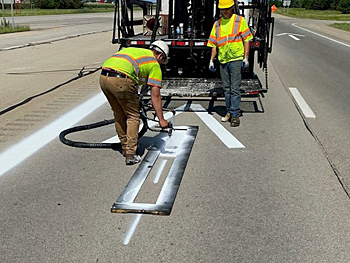ODOT, OSHP work on wrong-way drivers
Independent staff and submitted information
LIMA — The Ohio Department of Transportation (ODOT) and Ohio State Highway Patrol (OSHP) are working together to stop wrong-way drivers along the U.S. 30 corridor in Paulding and Van Wert counties.
Patrol data from the last five years show that wrong-way incidences are occurring at a rate 10 times higher than what is happening along other four-lane divided highways in the region.

“The number of incidences was quite startling and creates a very dangerous situation for drivers,” said Lt. Jonathon Gray , commander of the Van Wert OSHP post. “The resulting accidents tend to be very serious or fatal.”
According to OSHP, in the last five years, there have been 100 wrong-way driver incidences along this stretch of U.S. 30, including two fatal crashes resulting in three deaths.
The incidences tend to happen most often at night and on the weekend and tend to involve alcohol, older drivers, and those unfamiliar with the area.
“But many times, we are not able to determine what caused drivers to enter the wrong way,” said Lt. Gray. “By the time patrol officers get out there, the driver has realized their mistake and managed to get turned around or exited the highway.”
The statistics compelled ODOT to look at how to improve safety immediately.
“We already have a feasibility study underway to look at the U.S. 30 corridor and make a long-term plan to improve safety,” said ODOT District 1 Deputy Director Chris Hughes. “The project happening now is something we are implementing in the short-term to help drivers recognize the four-lane divided highway and correctly navigate the intersections.”
Last week, a project began to add pavement marking just prior to each of 18 intersections along the U.S 30 corridor in Van Wert and Paulding counties. Two arrows are to be painted in each mainline lane of the U.S. 30 intersections from State Line Road to Boroff Road.
The project is being funded through ODOT safety funds. The DeWine administration has committed approximately $150 million per year to address high-accident locations throughout the state.
The arrow pavement markings, often seen on interchange ramps, are ODOT”s first to use at intersections on divided highways. The work is being completed by DuraMark of Aurora.
Later this year, the project will also add more signs to call attention to the four-lane divided highway at each intersection. All 18 intersections will be nearly identical with:
- Route U.S. 30 signs.
- Dual “DO NOT ENTER’ signs on each side of U.S. 30.
- “ONE WAY, DO NOT ENTER”, and “WRONG WAY” signs in the medians.
- Plus additional dual “WRONG WAY” signs at the end of each intersection.
- Dual STOP signs will be larger and include signs depicting a divided highway
Lt. Gray said wrong-way drivers are confused and may not have realized they entered a four-lane divided highway.
“Always drive defensively and keep your eyes scanning down the road,” he said. “Be on the lookout for wrong-way drivers, especially at night, so if someone is driving the wrong way, you will have time to take evasive action.”
For drivers who do encounter a vehicle traveling the wrong way, Lt. Gray suggests slowing down and moving to the other lane or onto the berm to avoid a crash. Immediately call 9-1-1 and report the wrong-way driver. Give the location, direction of travel, and the best description of the vehicle possible.
The Ohio Department of Transportation and the Ohio State Highway Patrol will continue to identify safety issues and work together to ensure and establish safe corridors for all motorists who traverse Ohio’s roadways.
The U.S. 30 feasibility study is currently working with stakeholders to identify alternatives. A public meeting to share the results and discuss alternatives will be held this coming spring.
POSTED: 08/18/21 at 10:03 pm. FILED UNDER: News







